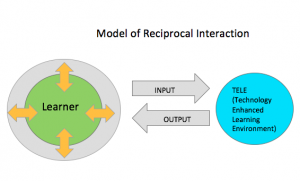Over the past century, it appears those who “excelled” in academia were those who could withstand boredom the longest. Students who can sit quietly, follow directions, read and write, as well as do what has always been done get good grades and are successful at school. Students who do not fit this mold are often seen as behaviour problems or as having attentional issues. But is this second cohort not the ones who are creative problem solvers, hands-on doers, collaborators who confidently tackle issues and invent new things?
The world has changed over the past one hundred years. Technology has totally redefined our daily lives. The workplace asks us for creative problem solvers who can collaborate and use critical thinking skills, and yet our classrooms, for the most part, have not changed. The curriculum and pedagogical techniques used by a majority of teachers are still the same. We continue to value the student who makes no waves in the classroom. It is a wonder we as educators have not died of boredom in the process along with our students.
The sad part of all this is that both sets of students are disenfranchised. The obedient putting in time, getting good grades and bored silly. The “difficult” student has less tolerance for boredom and appear to act out, but they are disenfranchised none the less. Innovative educators realize there is a problem in our classrooms and have set about to help motivate change. This is the case of the creators of the WISE program who use Technology to bring inquiry-based science and math lessons to the classroom. Inquiry-based learning brings the student into the role of investigator, problem solver and inference maker.
WISE (Web-based Inquiry Science Environment)design teams use the knowledge integration perspective to create inquiry projects that help students develop a more cohesive, coherent, and thoughtful account of scientific phenomena. The knowledge integration perspective suggests a general instructional pattern that involves eliciting the repertoire of student ideas, adding promising normative ideas to the mix, and supporting the process of combining, sorting, organizing, creating, and reflecting to improve understanding. WISE design teams create more precise, specialized, discipline- focused, and unique patterns of activities and technology features to tailor this general pattern to their specific goals, technology tools, and instructional contexts (Linn et Al., 2003 p. 521)
The developers of WISE use inquiry maps, prompts and reflection techniques to help guide the student through self-directed steps of investigation. WISE has adopted the Scaffolded Knowledge Integration (SKI) framework which uses curriculum enhanced with technology to build the student’s knowledge and understanding of scientific concepts and to help dispel misconceptions they bring to the science classroom. By using the four tenets of SKI: (1) making thinking visible, (2) making science accessible, (3) helping students learn from each other, and (4) promoting lifelong learning, the developers of WISE start with where the students are and develop a step by step program incorporating curriculum standards and technology to allow students to construct their own knowledge in unique ways (Linn et Al, 2003, p 522).
The typical WISE module goes through several iterations before it is allowed on the project board with no disclaimer. Researchers, educators, and technology experts work together to create an on-line module that students can investigate with little interruption to seek teacher assistance. The modules are tested, re-worked and re-tested before they are available to teachers. The modules integrate technology and inquiry into the science classroom. This process is successful in having students take ownership of their own learning and dispelling misconceptions they have. The modules also allow the students to take the learning further. In the WISE modules students uncover the material they need to solve problems and may have to discover information and make inferences on their own to successfully complete the unit.
This is different from the Jasper Woodley TELE we investigated last week. In the Jasper Woodley series students watch a video with no realization of how they will be using in the information they are presented with. The video stories provide the students with all the information they will require to solve a series of problems presented in sequence. Another difference between the two TELE’s is that the WISE series begins with a big picture problem and solves it in narrowly defined steps, the Jasper Woodley series starts with smaller steps and finishes with big picture inferences. One problem that arose in the Jasper Woodley series was that often, especially when working alone, students did not look at alternatives to the problem they solved rather they saw their mission as complete and moved on. It was only in using partners or groups that several methods were tried to solve the problem in the best way possible.
Personally, I see value in both TELEs. I would likely begin with the Jasper Woodley series. Allowing students to work in groups to solve problems, talk about their findings and dispel their misconceptions seems as an excellent way to build confidence, collaborative skills and risk taking. By using the Jasper Woodley series first students build the inquiry skills necessary to tackle the more advanced concepts in the WISE series. At first glance, being a grade 6-8 teacher, I thought several of the modules for grades 6-8 on WISE looked intimidating. If students are not taught how to navigate new problem-solving scenarios they would spend a lot of time overwhelmed by what they were expected to be learning. If they are taught the skills necessary to successfully navigate inquiry learning I believe the experience will be much more rewarding. Students who had worked through the Jasper Woodley problems would have the confidence to tackle the WISE modules.
One issue both TELE’s fail to address is the availability of the technology or equipment to run the programs successfully. Are there enough devices? Is the bandwidth adequate? My last area of concern is teacher training and confidence in delivering an inquiry-based program using a TELE. In the course reading Learning to Teach Inquiry Science in a Technology-Based Environment: A Case Study by Michelle Williams, Marcia C. Linn, Paul Ammon and Maryl Gearhart (2004) it was shown to take the teacher “Alice” (who was motivated and interested in trying a new technique) two years to become confident using the inquiry method. In my experience, most teachers would give up well before this and revert to their old pedagogical ways. They would see the inquiry method as yet another next best thing that didn’t work. Teacher professional development is paramount to programs like the Jasper Woodley series and WISE modules being successful.
Reference:
Linn, M., Clark, D., & Slotta, J. (2003). Wise design for knowledge integration. Science Education, 87(4), 517-538.
Williams, M. Linn, M.C. Ammon, P. & Gearhart, M. (2004). Learning to teach inquiry science in a technology-based environment: A case study. Journal of Science Education and Technology, 13(2), 189-206.

 As for my own definition, I would emphasize the idea that the technology is a tool to transform and transmit our learning. Technology is a tool, the effectiveness of a tool is not absolute, but is dependent upon how it is applied and new users may find novel uses for a particular tool. Technology is much bigger and more complex than a single device or site. The key driver in using technology in the classroom should be learning goals and how the technology can be used to achieve that goal. It does not have to appear in every lesson or unit, but should be strategically utilized to maximize the effectiveness of the tool, and student learning for the specific subject at hand. In science this may mean using a big screen and projector for a virtual visit to an archaeological site, or allowing students to manipulate tools to participate in a virtual dissection of a frog. It also might mean having technology readily available for students to create or find uses to enhance their learning while it is relevant to the moment. Technology should be like oxygen, ubiquitous, necessary, and invisible (Chris Lehmann). It should not be an addition to the learning, but an integral part of it, much like our pencil and paper.
As for my own definition, I would emphasize the idea that the technology is a tool to transform and transmit our learning. Technology is a tool, the effectiveness of a tool is not absolute, but is dependent upon how it is applied and new users may find novel uses for a particular tool. Technology is much bigger and more complex than a single device or site. The key driver in using technology in the classroom should be learning goals and how the technology can be used to achieve that goal. It does not have to appear in every lesson or unit, but should be strategically utilized to maximize the effectiveness of the tool, and student learning for the specific subject at hand. In science this may mean using a big screen and projector for a virtual visit to an archaeological site, or allowing students to manipulate tools to participate in a virtual dissection of a frog. It also might mean having technology readily available for students to create or find uses to enhance their learning while it is relevant to the moment. Technology should be like oxygen, ubiquitous, necessary, and invisible (Chris Lehmann). It should not be an addition to the learning, but an integral part of it, much like our pencil and paper.